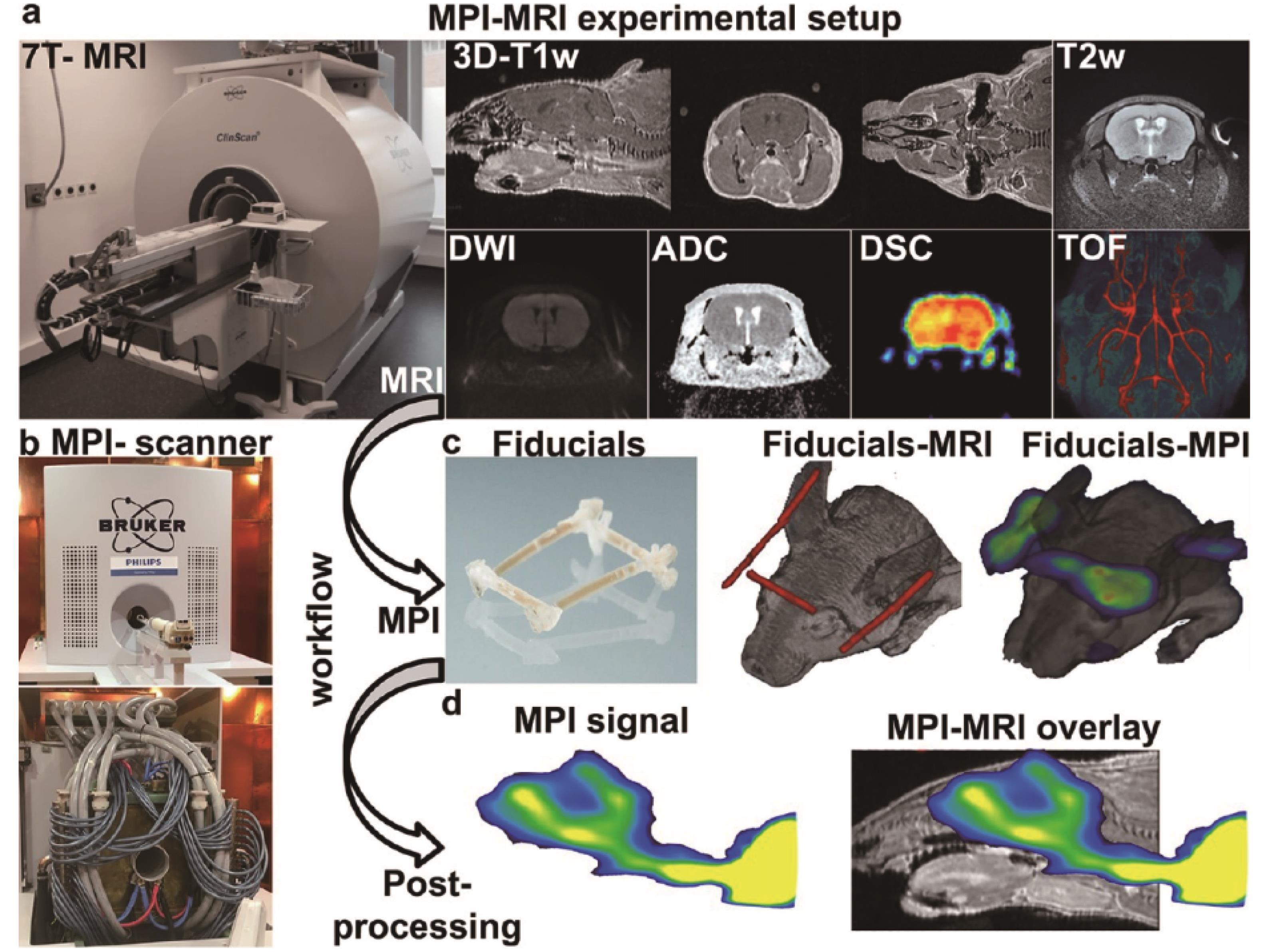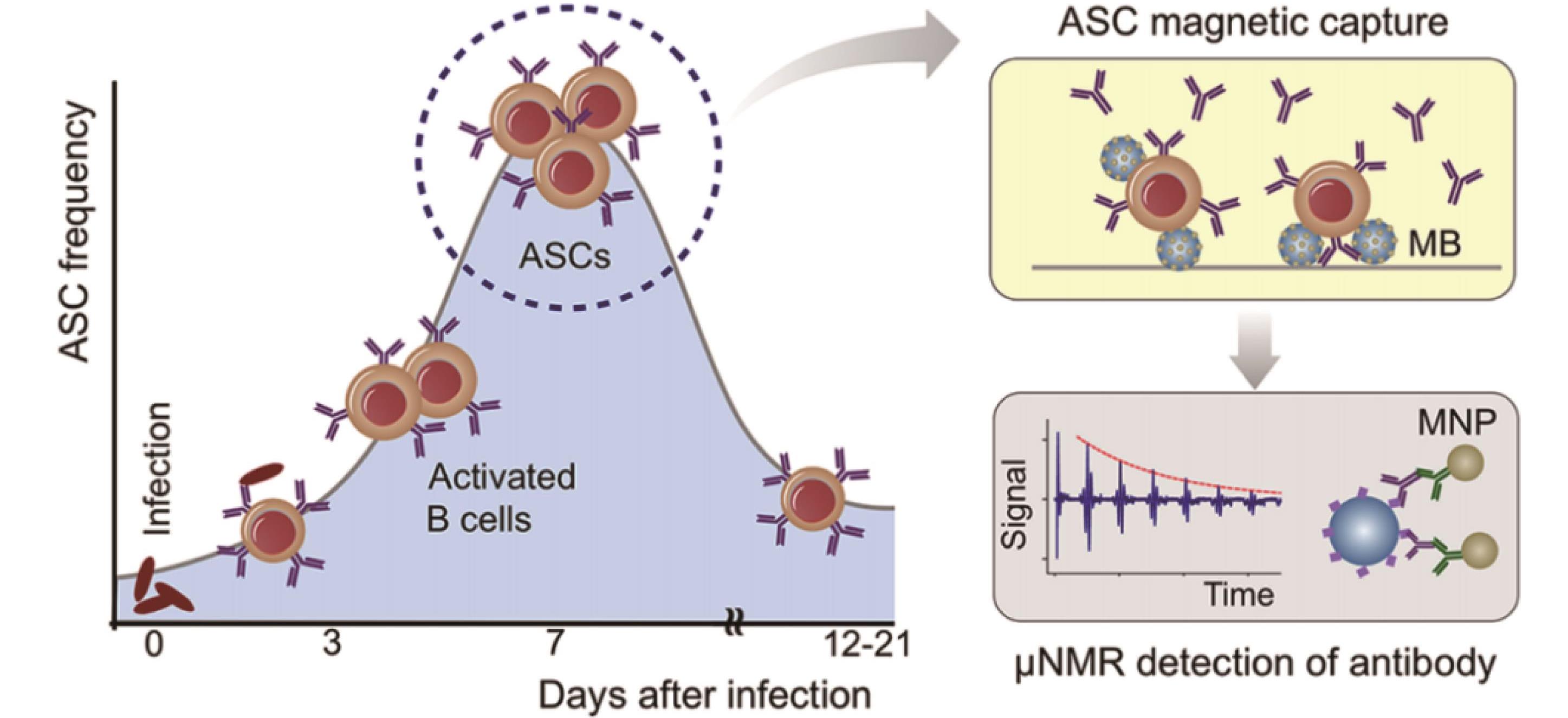
Chinese Journal of Applied Chemistry ›› 2022, Vol. 39 ›› Issue (3): 391-406.DOI: 10.19894/j.issn.1000-0518.210394
• Review • Previous Articles Next Articles
Applications of Transition Metal⁃doped Iron⁃based Nanoparticles in Biomedicine
Hui DU1,3, Chen-Yang YAO1,3, Hao PENG1,3, Bo JIANG1, Shun-Xiang LI1, Jun-Lie YAO1, Fang ZHENG1, Fang YANG1,2( ), Ai-Guo WU1,2(
), Ai-Guo WU1,2( )
)
- 1.Zhejiang Biomedical Materials Technology and Application International Science and Technology Cooperation Base,Key Laboratory of Magnetic Materials and Devices,Zhejiang Engineering Research Center for ImplantInterventional Materials,Cixi Institute of Biomedical Engineering,Ningbo Institute of Materials Technologyand Engineering,Chinese Academy of Sciences,Ningbo 315201,China
2.Guangdong Laboratory of Advanced Energy Science and Technology,Huizhou 516000,China
3.University of Chinese Academy of Sciences,Beijing 100049,China
-
Received:2021-08-07Accepted:2021-11-03Published:2022-03-01Online:2022-03-15 -
Contact:Fang YANG,Ai-Guo WU -
About author:yangf@nimte.ac.cn; aiguo@nimte.ac.cn
-
Supported by:the National Natural Science Foundation of China(32025021);the Ministry of Science and Technology of China(2018YFC0910601);the Department of Science and Technology of Zhejiang Province(2020C03110);the Science and Technology Bureau of Ningbo Municipality(2020Z094)
CLC Number:
Cite this article
Hui DU, Chen-Yang YAO, Hao PENG, Bo JIANG, Shun-Xiang LI, Jun-Lie YAO, Fang ZHENG, Fang YANG, Ai-Guo WU. Applications of Transition Metal⁃doped Iron⁃based Nanoparticles in Biomedicine[J]. Chinese Journal of Applied Chemistry, 2022, 39(3): 391-406.
share this article
Add to citation manager EndNote|Ris|BibTeX
URL: http://yyhx.ciac.jl.cn/EN/10.19894/j.issn.1000-0518.210394
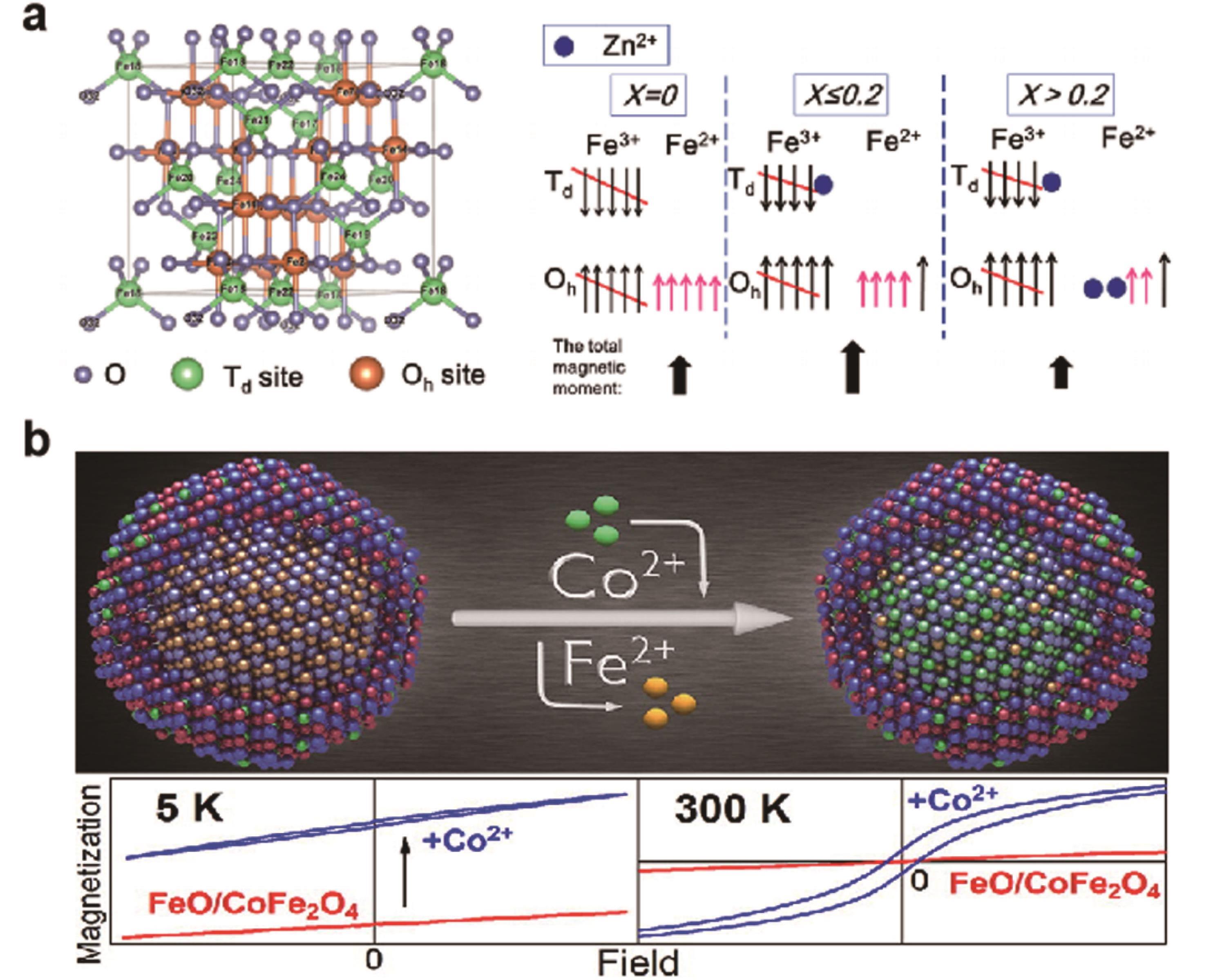
Fig.2 (a) Doping mechanism of ferrite with different zinc doping and its total magnetic moment in oleic acid/alcohol/water system[8]. (b) Effect of Co2+ doping into ferrite in the form of ion exchange on its coercivity[9]
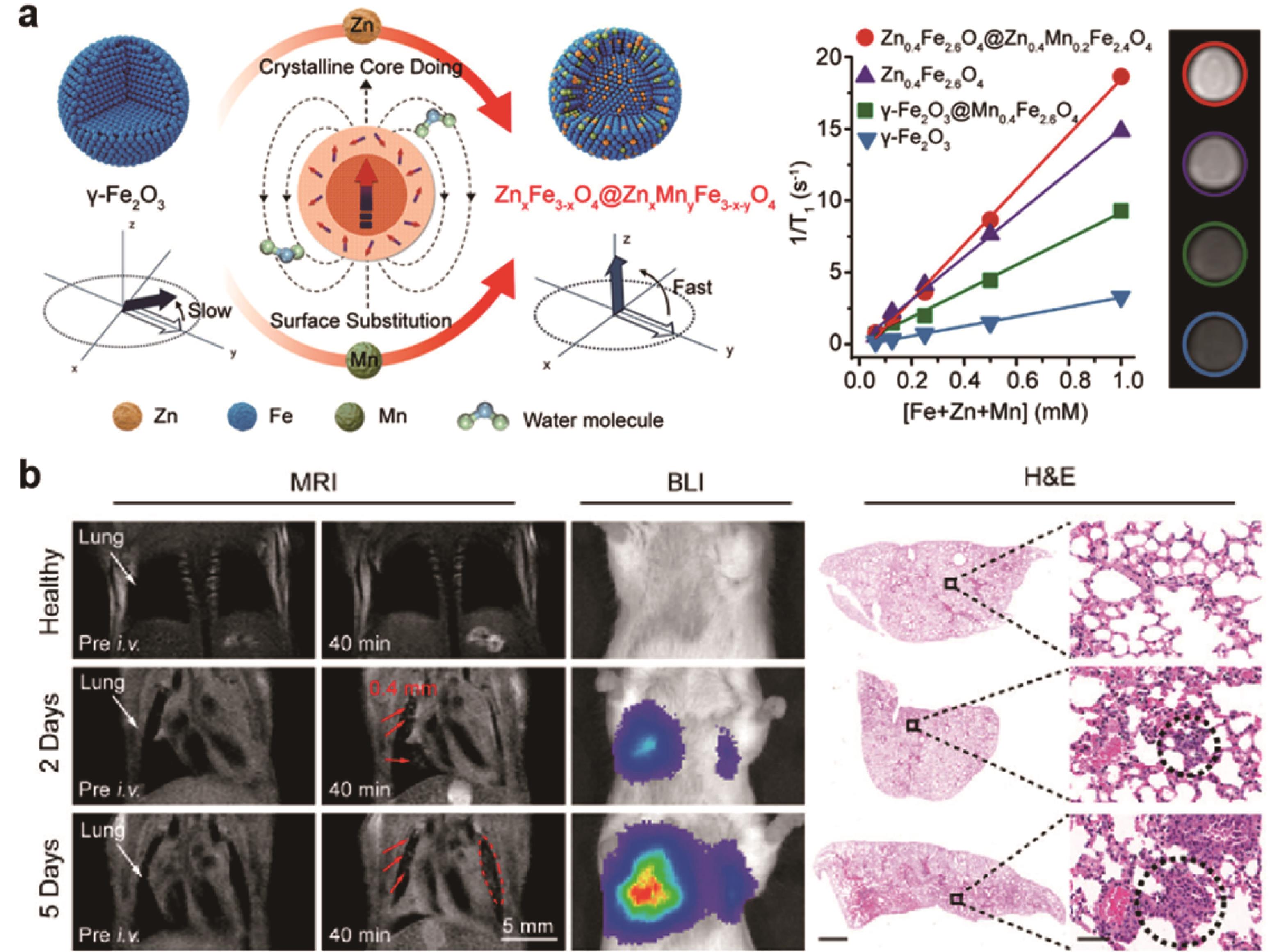
Fig.3 (a) Mechanistic diagram of doping Zn2+ and Mn2+ into γ-Fe2O3 and the T1-weighted imaging effect of the synthesized MNPs[14]. (b) MRI T1-weighted images of metastases in mice of Zn0.4F@Zn0.4Mn0.2F-AMD, BLI images and H&E images of the lung (scale bar: left, 1 mm; right, 50 μm)[14]
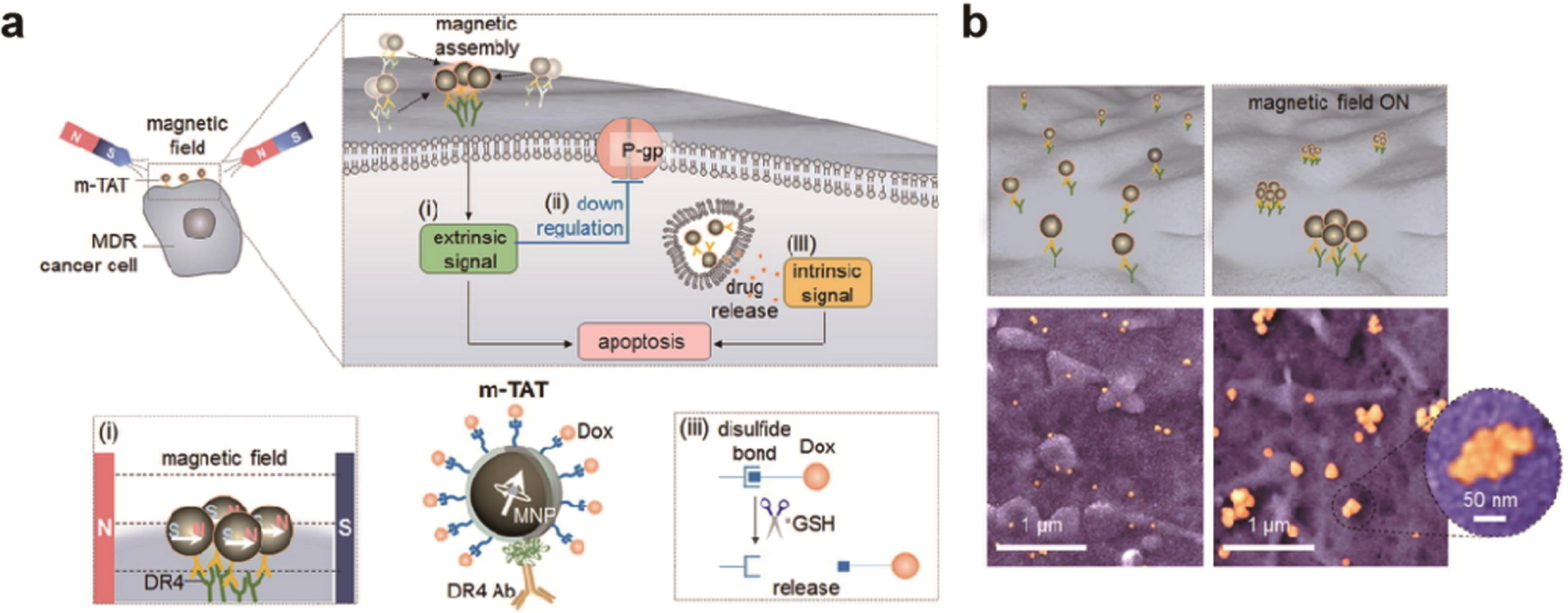
Fig.5 (a) Aggregation strategy based on magnetic nanoparticles to activate apoptotic signaling: magnetic switch aggregates death receptor 4 (DR4), which is used to induce apoptosis by TRAIL mimicking biochemical signaling[37]; (b) Scanning electron microscopy (SEM) images of M-TAT on the surface of cells[37]
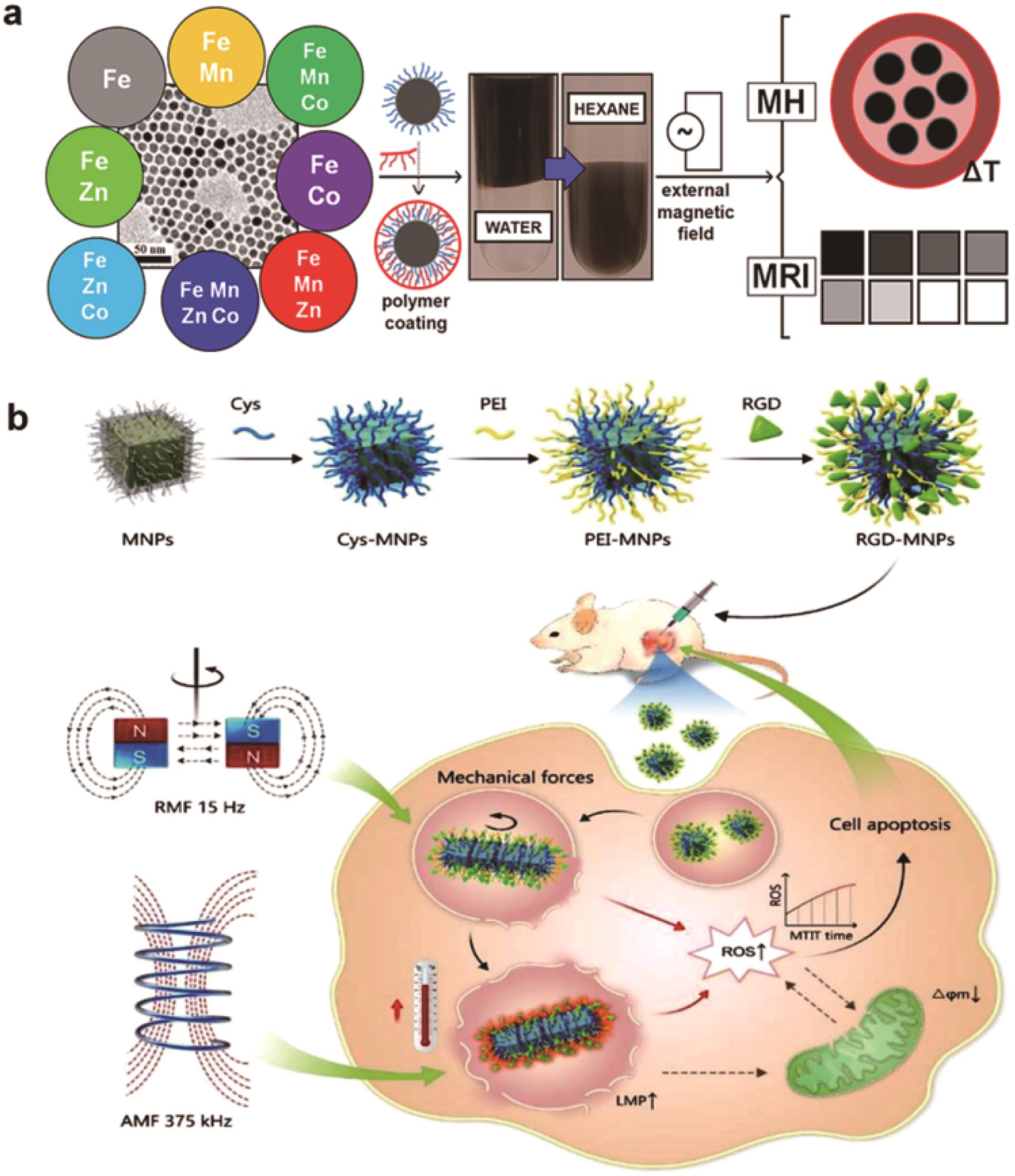
Fig.6 (a) Multicomponent (Mn, Zn, Co) doped ferrite for magnetothermal studies[49]; (b) Magneto-mechanical force based on spin- field assembly and high frequency alternating magnetic field triggered magnetothermal synergy therapy (MTIT)[51]
| 1 | HU Y, MIGNANI S, MAJORAL J P, et al. Construction of iron oxide nanoparticle-based hybrid platforms for tumor imaging and therapy[J]. Chem Soc Rev, 2018, 47(5): 1874-1900. |
| 2 | POON W, KINGSTON B R, OUYANG B, et al. A framework for designing delivery systems[J]. Nat Nanotechnol, 2020, 15(10): 819-829. |
| 3 | WANG J, LI Y, NIE G. Multifunctional biomolecule nanostructures for cancer therapy[J]. Nat Rev Mater, 2021: 1-18. |
| 4 | WILLIAMS A R, MORUZZI V L, GELATT C D, et al. Aspects of transition-metal magnetism[J]. J Appl Phy, 1982, 53(3): 2019-2023. |
| 5 | JANG J T, NAH H, LEE J H, et al. Critical enhancements of MRI contrast and hyperthermic effects by dopant-controlled magnetic nanoparticles[J]. Angew Chem Int Ed Engl, 2009, 48(7): 1234-1242. |
| 6 | LIU C, ZOtU B, RONDINONE A J, et al. Chemical Control of superparamagnetic properties of magnesium and cobalt spinel ferrie nanoparticles through atomic level magnetic couplings[J]. J Am Chem Soc, 2000, 122(26): 6263-6267. |
| 7 | LEE J H, HUH Y M, JUN Y W, et al. Artificially engineered magnetic nanoparticles for ultra-sensitive molecular imaging[J]. Nat Med, 2007, 13(1): 95-99. |
| 8 | FRAGA C G. Relevance, essentiality and toxicity of trace elements in human health[J]. Mol Asp Med, 2005, 26(4/5): 235-244. |
| 9 | LANDSIEDEL R, MA-HOCK L, KROLL A, et al. Testing metal-oxide nanomaterials for human safety[J]. Adv Mater, 2010, 22(24): 2601-2627. |
| 10 | MA Y, XIA J, YAO C, et al. Precisely tuning the contrast properties of ZnxFe3– xO4 nanoparticles in magnetic resonance imaging by controlling their doping content and size[J]. Chem Mater, 2019, 31(18): 7255-7264. |
| 11 | SYTNYK M, KIRCHSCHLAGER R, BODNARCHUK M I, et al. Tuning the magnetic properties of metal oxide nanocrystal heterostructures by cation exchange[J]. Nano Lett, 2013, 13(2): 586-593. |
| 12 | GABAL M A, BAYOUMY W A. Effect of composition on structural and magnetic properties of nanocrystalline Ni0.8- xZn0.2MgxFe2O4 ferrite[J]. Polyhedron, 2010, 29(13): 2569-2573. |
| 13 | ZHOU Z, YANG L, GAO J, et al. Structure-relaxivity relationships of magnetic nanoparticles for magnetic resonance imaging[J]. Adv Mater, 2019, 31(8): e1804567. |
| 14 | MIAO Y, ZHANG H, CAI J, et al. Structure-relaxivity mechanism of an ultrasmall ferrite nanoparticle T1 MR contrast agent: the impact of dopants controlled crystalline core and surface disordered shell[J]. Nano Lett, 2021, 21(2): 1115-1123. |
| 15 | CHOI J S, KIM S, YOO D, et al. Distance-dependent magnetic resonance tuning as a versatile MRI sensing platform for biological targets[J]. Nat Mater, 2017, 16(5): 537-542. |
| 16 | SHIN T H, KANG S, PARK S, et al. A magnetic resonance tuning sensor for the MRI detection of biological targets[J]. Nat Protoc, 2018, 13(11): 2664-2684. |
| 17 | GLEICH B, WEIZENECKER R. Tomographic imaging using the nonlinear response of magnetic particles[J]. Nature, 2005, 435(7046): 1214-1217. |
| 18 | GOODWILL P W, SARITAS E U, CROFT L R, et al. X-space MPI: magnetic nanoparticles for safe medical imaging[J]. Adv Mater, 2012, 24(28): 3870-3877. |
| 19 | LEMASTER J E, CHEN F, KIM T, et al. Development of a trimodal contrast agent for acoustic and magnetic particle imaging of stem cells[J]. ACS Appl Nano Mater, 2018, 1(3): 1321-1331. |
| 20 | WU L, MENDOZA-GARCIA A, LI Q, et al. Organic phase syntheses of magnetic nanoparticles and their applications[J]. Chem Rev, 2016, 116(18): 10473-10512. |
| 21 | SONG G, KENNEY M, CHEN Y S, et al. Carbon-coated FeCo nanoparticles as sensitive magnetic-particle-imaging tracers with photothermal and magnetothermal properties[J]. Nat Biomed Eng, 2020, 4(3): 325-334. |
| 22 | ARAMI H, TEEMAN E, TROKSA A, et al. Tomographic magnetic particle imaging of cancer targeted nanoparticles[J]. Nanoscale, 2017, 9(47): 18723-18730. |
| 23 | LUDEWIG P, GDANIEC N, SEDLACIK J, et al. Magnetic particle imaging for real-time perfusion imaging in acute stroke[J]. ACS Nano, 2017, 11(10): 10480-10488. |
| 24 | SONG G, CHEN M, ZHANG Y, et al. Janus iron oxides@semiconducting polymer nanoparticle tracer for cell tracking by magnetic particle imaging[J]. Nano Lett, 2018, 18(1): 182-189. |
| 25 | BAUER L M, SITU S F, GRISWOLD M A, et al. High-performance iron oxide nanoparticles for magnetic particle imaging - guided hyperthermia (hMPI)[J]. Nanoscale, 2016, 8(24): 12162-12169. |
| 26 | JIANG Z, HAN X, DU Y, et al. Mixed metal metal-organic frameworks derived carbon supporting ZnFe2O4/C for high-performance magnetic particle imaging[J]. Nano Lett, 2021, 21(7): 2730-2737. |
| 27 | DU Y, LIU X, LIANG Q, et al. Optimization and design of magnetic ferrite nanoparticles with uniform tumor distribution for highly sensitive MRI/MPI performance and improved magnetic hyperthermia therapy[J]. Nano Lett, 2019, 19(6): 3618-3626. |
| 28 | MÜLLER D J, HELENIUS J, ALSTEENS D, et al. Force probing surfaces of living cells to molecular resolution[J]. Nat Chem Biol, 2009, 5(6): 383-390. |
| 29 | CHENG Y, MUROSKI M E, PETIT D, et al. Rotating magnetic field induced oscillation of magnetic particles for in vivo mechanical destruction of malignant glioma[J]. J Control Release, 2016, 223: 75-84. |
| 30 | XIA Y, SUN J, ZHAO L, et al. Magnetic field and nano-scaffolds with stem cells to enhance bone regeneration[J]. Biomaterials, 2018, 183: 151-170. |
| 31 | GAHL T J, KUNZE A. Force-mediating magnetic nanoparticles to engineer neuronal cell function[J]. Front Neurosci, 2018, 12: 299. |
| 32 | WU C, SHEN Y, CHEN M, et al. Recent advances in magnetic-nanomaterial-based mechanotransduction for cell fate regulation[J]. Adv Mater, 2018, 30(17): e1705673. |
| 33 | LIU H, WEN J, XIAO Y, et al. In situ mechanical characterization of the cell nucleus by atomic force microscopy[J]. ACS Nano, 2014, 8(4): 3821-3829. |
| 34 | YUN H M, AHN S J, PARK K R, et al. Magnetic nanocomposite scaffolds combined with static magnetic field in the stimulation of osteoblastic differentiation and bone formation[J]. Biomaterials, 2016, 85: 88-98. |
| 35 | CHENYANG Y, FANG Y, LI S, et al. Magnetically switchable mechano-chemotherapy for enhancing the death of tumour cells by overcoming drug-resistance[J]. Nano Today, 2020, 35: 100967. |
| 36 | YUAN Y, DING Z, QIAN J, et al. Casp3/7-instructed intracellular aggregation of Fe3O4 nanoparticles enhances T2 MR imaging of tumor apoptosis[J]. Nano Lett, 2016, 16(4): 2686-2691. |
| 37 | CHO M H, KIM S, LEE J H, et al. Magnetic tandem apoptosis for overcoming multidrug-resistant cancer[J]. Nano Lett, 2016, 16(12): 7455-7460. |
| 38 | ZHANG E, KIRCHER M F, KOCH M, et al. Dynamic magnetic fields remote-control apoptosis via nanoparticle rotation[J]. ACS Nano, 2014, 8(4): 3192-3201. |
| 39 | DOMENECH M, MARRERO-BERRIO I, TORRES-LUGO M, et al. Lysosomal membrane permeabilization by targeted magnetic nanoparticles in alternating magnetic fields[J]. ACS Nano, 2013, 7(6): 5091. |
| 40 | CHEN M, WU J, NING P, et al. Remote control of mechanical forces via mitochondrial-targeted magnetic nanospinners for efficient cancer treatment[J]. Small, 2020, 16(3): e1905424. |
| 41 | BRAY F, FERLAY J, SOERJOMATARAM I, et al. Global cancer statistics 2018: GLOBOCAN estimates of incidence and mortality worldwide for 36 cancers in 185 countries[J]. CA Cancer J Clin, 2018, 68(6): 394-424. |
| 42 | NOH S H, MOON S H, SHIN T H, et al. Recent advances of magneto-thermal capabilities of nanoparticles: from design principles to biomedical applications[J]. Nano Today, 2017, 13: 61-76. |
| 43 | MARMUGI L, RENZONI F. Optical magnetic induction tomography of the heart[J]. Sci Rep, 2016, 6: 23962. |
| 44 | LEE N, YOO D, LING D, et al. Iron oxide based nanoparticles for multimodal imaging and magnetoresponsive therapy[J]. Chem Rev, 2015, 115(19): 10637-10689. |
| 45 | LIU T Y, HU S H, LIU D M, et al. Biomedical nanoparticle carriers with combined thermal and magnetic responses[J]. Nano Today, 2009, 4(1): 52-65. |
| 46 | YOO D, JEONG H, NOH S H, et al. Magnetically triggered dual functional nanoparticles for resistance‐free apoptotic hyperthermia[J]. Angew Chem Int Ed, 2013, 52(49): 13047-13051. |
| 47 | HERGT R, DUTZ S, ZEISBERGER M. Validity limits of the Néel relaxation model of magnetic nanoparticles for hyperthermia[J]. Nanotechnology, 2010, 21(1): 015706. |
| 48 | DAS P, COLOMBO M, PROSPERI D. Recent advances in magnetic fluid hyperthermia for cancer therapy[J]. Colloids Surf B Biointerfaces, 2019, 174: 42-55. |
| 49 | PARDO A, PELAZ B, GALLO J, et al. Synthesis, characterization, and evaluation of superparamagnetic doped ferrites as potential therapeutic nanotools[J]. Chem Mater, 2020, 32(6): 2220-2231. |
| 50 | CASTELLANOS-RUBIO I, ARRIORTUA O, MARCANO L, et al. Shaping up Zn-doped magnetite nanoparticles from mono- and bimetallic oleates: the impact of Zn content, Fe vacancies, and morphology on magnetic hyperthermia performance[J]. Chem Mater, 2021, 33(9): 3139-3154. |
| 51 | WU J, NING P, GAO R, et al. Programmable ROS-mediated cancer therapy via magneto-inductions[J]. Adv Sci, 2020, 7(12): 1902933. |
| 52 | YOO D, JEONG H, NOH S H, et al. Magnetically triggered dual functional nanoparticles for resistance-free apoptotic hyperthermia[J]. Angew Chem Int Ed Engl, 2013, 52(49): 13047-13051. |
| 53 | YIN P T, SHAH S, PASQUALE N J, et al. Stem cell-based gene therapy activated using magnetic hyperthermia to enhance the treatment of cancer[J]. Biomaterials, 2016, 81: 46-57. |
| 54 | WILHELM S, TAVARES A J, DAI Q, et al. Analysis of nanoparticle delivery to tumours[J]. Nat Rev Mater, 2016, 1(5): 16014. |
| 55 | FREEMAN M W, ARROTT A, WATSON J H L. Magnetism in medicine[J]. J Appl Phys, 1960, 31(5): S404-S405. |
| 56 | SUN C, LEE J, ZHANG M. Magnetic nanoparticles in MR imaging and drug delivery[J]. Adv Drug Delivery Rev, 2008, 60(11): 1252-1265. |
| 57 | LüBBE A, BERGEMANN C. Selected preclinical and first clinical experiences with magnetically targeted 4'-epidoxorubicin in patients with advanced solid tumor.in: Häfeli U, Schütt W, Teller J, et al. Scientific and Clinical Applications of Magnetic Carriers[M]. Boston, MA: Springer, 1997: 457-480. https://doi.org/10.1007/978-1-4757-6482-6_35 |
| 58 | LUBBE A S, ALEXIOU C, BERGEMANN C. Clinical applications of magnetic drug targeting[J]. J Surg Res, 2001, 95(2): 200-206. |
| 59 | ROTARIU O, STRACHAN N J C. Modelling magnetic carrier particle targeting in the tumor microvasculature for cancer treatment[J]. J Magn Magn Mater, 2005, 293(1): 639-646. |
| 60 | GRAESER M, THIEBEN F, SZWARGULSKI P, et al. Human-sized magnetic particle imaging for brain applications[J]. Nat Commun, 2019, 10(1): 1936. |
| 61 | ZHOU Z, SHEN Z, CHEN X. Tale of two magnets: an advanced magnetic targeting system[J]. ACS Nano, 2019, 14(1): 7-11. |
| 62 | XIE M, ZHANG W, FAN C, et al. Bioinspired soft microrobots with precise magneto-collective control for microvascular thrombolysis[J]. Adv Mater, 2020, 32(26): 2000366. |
| 63 | GOODING J J, GAUS K. Single-molecule sensors: challenges and opportunities for quantitative analysis[J]. Angew Chem Int Ed Engl, 2016, 55(38): 11354-11366. |
| 64 | GLOAG L, MEHDIPOUR M, CHEN D, et al. Advances in the application of magnetic nanoparticles for sensing[J]. Adv Mater, 2019, 31(48): e1904385. |
| 65 | RISSIN D M, KAN C W, CAMPBELL T G, et al. Single-molecule enzyme-linked immunosorbent assay detects serum proteins at subfemtomolar concentrations[J]. Nat Biotechnol, 2010, 28(6): 595-599. |
| 66 | HAO L, LENG Y, ZENG L, et al. Core-Shell-heterostructured magnetic-plasmonic nanoassemblies with highly retained magnetic-plasmonic activities for ultrasensitive bioanalysis in complex matrix[J]. Adv Sci, 2020, 7(2): 1902433. |
| 67 | CAO X. Zinc ferrite nanoparticles: simple synthesis via lyophilisation and electrochemical application as glucose biosensor[J]. Nano Express, 2021, 2(2):024001. |
| 68 | SABALE S R. Studies on catalytic activity of MnFe2O4 and CoFe2O4 MNPsas mediators in hemoglobin based biosensor[J]. Mater Today: Proc, 2020, 23: 139-146. |
| 69 | PARK K S, KIM H, KIM S, et al. Nanomagnetic system for rapid diagnosis of acute infection[J]. ACS Nano, 2017, 11(11): 11425-11432. |
| 70 | MARKUS M. Physical limits to magnetogenetics[J]. Elife, 2016, 5: e17210. |
| 71 | BOLES M A, LING D, HYEON T, et al. Erratum: the surface science of nanocrystals[J]. Nat Mater, 2016, 15(3): 364-364. |
| 72 | PAPAEFTHYMIOU G C. The Mssbauer and magnetic properties of ferritin cores[J]. Biochim Biophys Acta Gen Subj, 2010, 1800(8): 886-897. |
| [1] | Xin-Tao XIE, Sang-Ni JIANG, Xi-Fei YU. Selective Binding pH Responsive Liposomes with Phenylboronic Acid for Drug Delivery [J]. Chinese Journal of Applied Chemistry, 2023, 40(6): 860-870. |
| [2] | CHENG Cui-Lin, MA Jia-Pei, WANG Wei-Chen, WANG Bo-Yang, WANG Zhen-Yu. Application of Electrospinning Technology of Natural Products in Biomedicine [J]. Chinese Journal of Applied Chemistry, 2021, 38(6): 605-614. |
| [3] | LI Xinyi,WANG Xiaohua,ZHOU Xiaodong,HU Jiming. Research Progress on Biosensing Based on Peptides and Gold Nanoparticles Composite Materials [J]. Chinese Journal of Applied Chemistry, 2019, 36(5): 489-499. |
| [4] | FAN Ye, HAN Yichen, XIA Yongmei, BO Chunling, WANG Shuyu, FANG Yun. Investigation on Self-assembly of Nanocontainers by Vesiculation of Conjugated Linoleic Acid and Sodium Alginate and Their Drug Delivery Behavior [J]. Chinese Journal of Applied Chemistry, 2018, 35(12): 1478-1484. |
| [5] | HUANG Zike, LIU Chao, FU Qiangqiang, LI Jin, ZOU Jianmei, XIE Sitao, QIU Liping. Aptamer-based Fluorescence Probe for Bioanalysis and Bioimaging [J]. Chinese Journal of Applied Chemistry, 2018, 35(1): 28-39. |
| [6] | HUANG Qiongwei,ZHAO Li,SONG Zhiming,FENG Xiangru,DING Jianxun. Phenylboronic Acid-Based Glucose-Sensitive Polymer Nanocarriers Used as Drug Delivery Systems [J]. Chinese Journal of Applied Chemistry, 2017, 34(7): 733-743. |
| [7] | Jia ZHOU, Yun NI, Chengwu ZHANG, Xinghan QIU, Yanfei ZHAO, Lei BAI, Gaobin ZHANG, Lin LI. Design and Synthesis of Pyrimidine Based Two-Photon Fluorescence Probe and Its Application in Bioimaging [J]. Chinese Journal of Applied Chemistry, 2017, 34(12): 1450-1456. |
| [8] | Jia ZHOU, Yun NI, Chengwu ZHANG, Xinghan QIU, Yanfei ZHAO, Lei BAI, Gaobin ZHANG, Lin LI. Design and Synthesis of Pyrimidine Based Two-Photon Fluorescence Probe and Its Application in Bioimaging [J]. Chinese Journal of Applied Chemistry, 2017, 34(12): 0-0. |
| [9] | LI Junrong,SHEN Aiguo,HU Jiming. Research Progress of Nanozymes and Its Application in Analysis [J]. Chinese Journal of Applied Chemistry, 2016, 33(11): 1245-1252. |
| [10] | ZHANG Yi, WU Lingbo, HU Qian, CHEN Baoxin, Wu Boyang, XUE Wei . Functionally Modified Hyperbranched Polyglycerols for Drug Delivery [J]. Chinese Journal of Applied Chemistry, 2015, 32(4): 367-378. |
| [11] | ZHANG Li1,2, ZHANG Jian2, ZHANG Zulei2, LIU Haiqing2, LI Lei1,2*. Preparation of Magnetic Nanomaterials and Its Adsorption Properties Towards Cr2O2-7 [J]. Chinese Journal of Applied Chemistry, 2013, 30(08): 927-931. |
| [12] | WU Cheng-Yao1, XIE Jian-Gang1,2, QUAN Jing1*, ZHU Li-Min1*, BAO Jin-Yue3, ZHOU Hong-Qiang3. Preparation and Sustained-release of Ketoprofen Polymeric Prodrug with Glucose Pendant [J]. Chinese Journal of Applied Chemistry, 2010, 27(12): 1386-1391. |
| Viewed | ||||||
|
Full text |
|
|||||
|
Abstract |
|
|||||

